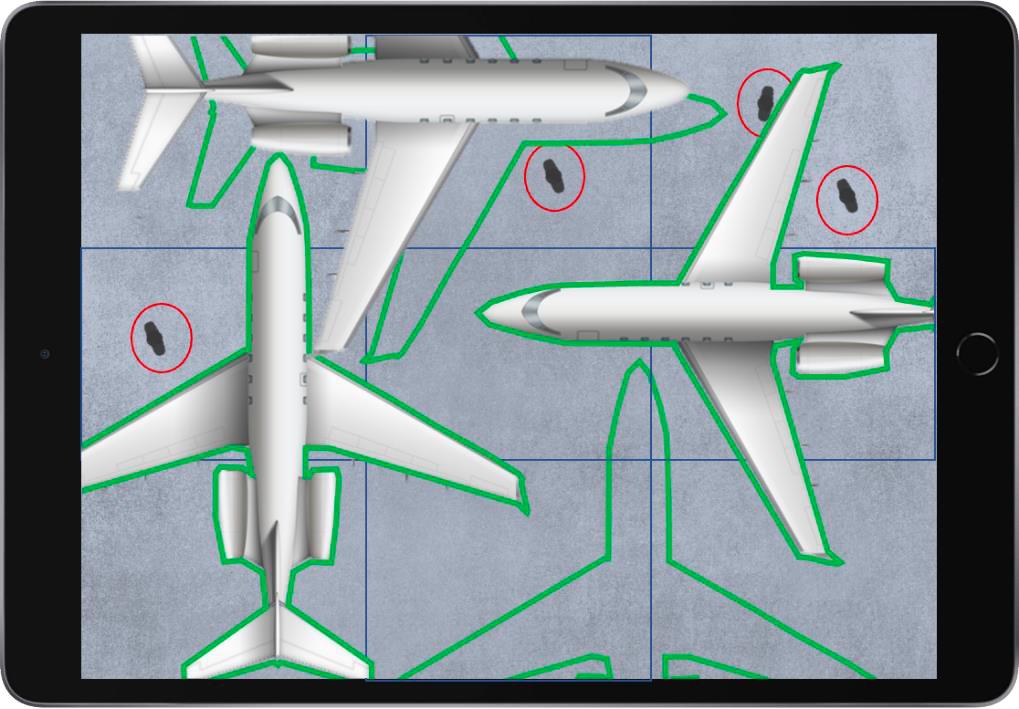
A new startup has created a smart hangar technology system designed to help MROs, FBOs and corporate flight departments reduce the risk of damaging aircraft during ground movement.
Fyve By’s system uses artificial intelligence and Internet of Things technology to provide real-time visual tracking of aircraft, cargo, tools and staff in a maintenance operations space. The system pairs cameras mounted to the ceiling and walls of a hangar with sensors and software to create a 3D replica of a hangar. The replica is streamed to a tablet so an operator can keep track of equipment and personnel to reduce potential hazards. “The analogy we like to use is the 360-deg. backup camera in a car,” explains Preston LaVangie, co-founder of Fyve By. “We provide that [functionality] for an aircraft that’s moving back into a hangar so we don’t nick any walls, vehicles or other airplanes.”
The startup is working with several private MROs and operators to test and develop the technology. It is building a computer learning function to identify potential hazards—such as external power units, batteries or toolboxes—and to notify operators if they interfere with the path of aircraft travel.
According to Benjamin Youngstrom, Fyve By’s other co-founder, the startup already has witnessed use cases where its technology could have prevented costly damage. While meeting with a customer at Fyve By’s office space at DeKalb-Peachtree Airport, Youngstrom says he watched as a ground crew accidentally backed a Pilatus PC-12 directly into a wall, causing the tail to fold down over the fuselage. “In that scenario, with our system, you would have a tablet mounted to your tractor or tug,” he says. Instead of needing to be warned by coworkers about a potential collision, the operator “would be able to very literally see on their tablet that they’re approaching an obstacle. There’s a marker that shows them distance and how far they are.”

Credit: Fyve By
In addition to its hazard tracking functionality, the smart hangar system can also be used for security monitoring and more efficiently managing aircraft positioning within the hangar. “A lot of the solutions for hangar stacking right now are kind of what we would call ‘dumb solutions,’" says Youngstrom. “They are not intelligently enabled,” so it is more like “playing your own game of Tetris within a pre-rendered hangar space. Since our system is capable of identifying not only where aircraft are, but what kind of aircraft they are and what their dimensions are in the space, we can run a multi-dimensional algorithm that’s identifying open opportunity space.”
Fyve By says this functionality can help maintenance providers increase space use efficiency by 10-15%. The algorithm can also be programmed for overlapping or non-overlapping aircraft configurations and safety margins of error, so customers can choose how much distance is maintained between aircraft.
While the system has so far only been tested in smaller hangars with business and general aviation aircraft, Youngstrom says Fyve By is working to scale the technology to larger commercial aircraft. “Applying the technology to aircraft of that size is still a couple years out, but we are rapidly building toward being able to employ it at large international and regional airports with commercial aircraft,” he says.
The technology has also proven interesting for insurance purposes. Youngstrom says one of Fyve By’s first testers was involved in an insurance claim when it found a dent on top of an aircraft that was delivered to it for maintenance. “When [the testing company] reported it to their client, their client insisted that the damage had never been there before and they must have done it,” he says. “After going back to the footage from our system as they moved the airplane in, they found that the dent had been there since the day it was delivered,” which protected the company from liability. He adds that Fyve By is beginning to talk with insurance providers about providing incentives for adopting the system.
Fyve By is actively looking for more industry partners to test and develop the technology. “Since we’re using computer learning, we need to take some time for the computer to learn. As we approach market readiness, we’re looking for more people to adopt the technology,” says Youngstrom.
The startup plans to roll out hangar stacking and some hazard marker functionality throughout 2023. Youngstrom says Fyve By is on track to release “some of the smarter analytics” in 2024.
Customers can currently lease the system for $1,000 a month per hangar, and Fyve By says the price to purchase the system varies depending on an assessment of customer needs. The system uses approximately 8-10 cameras when deployed in smaller hangars, but LaVangie says Fyve By is looking into ways to reduce the number of cameras to make installation easier. He adds that most of the system runs locally on a server installed inside the hangar to improve software speed, but it also uses cloud backups.




